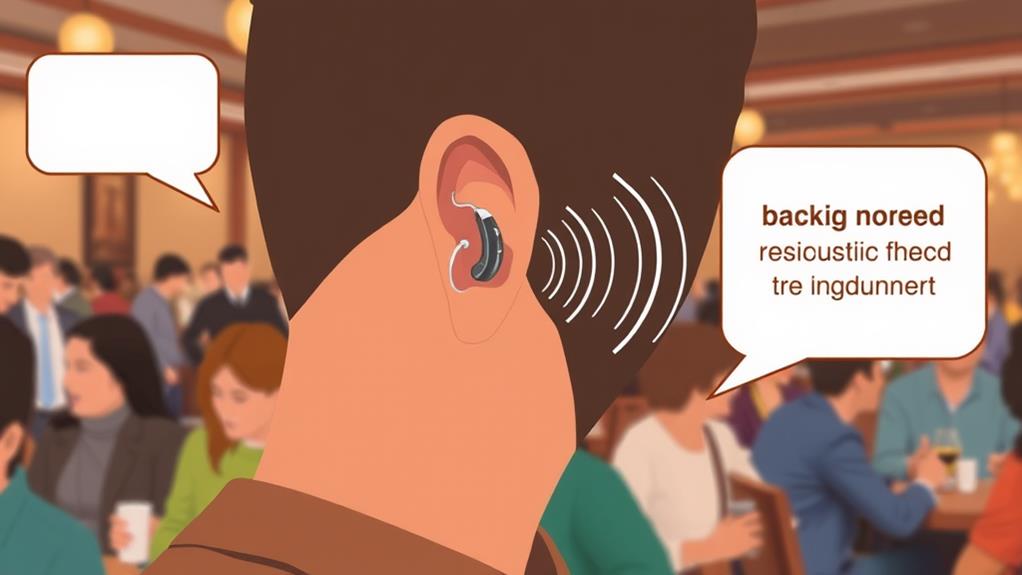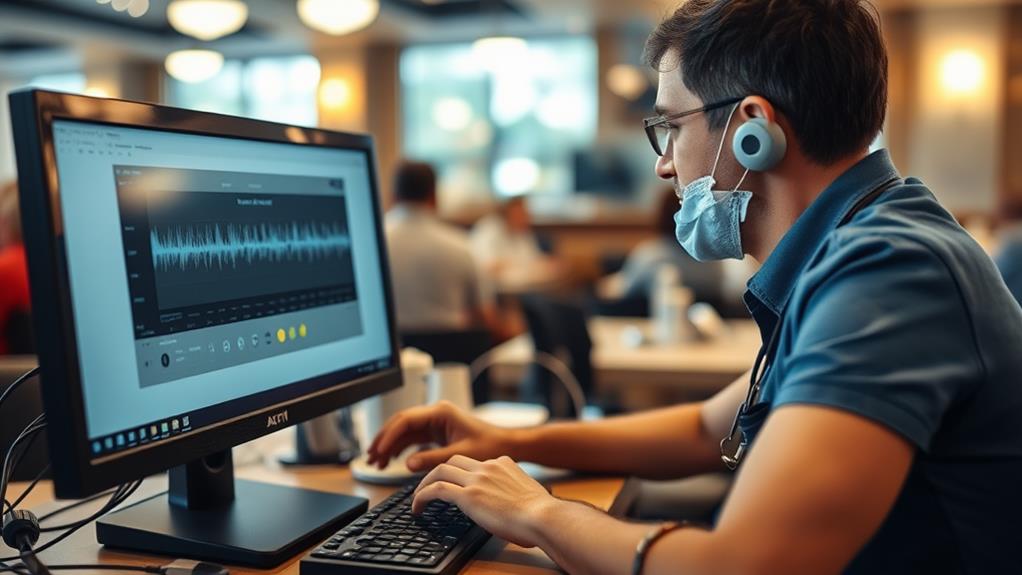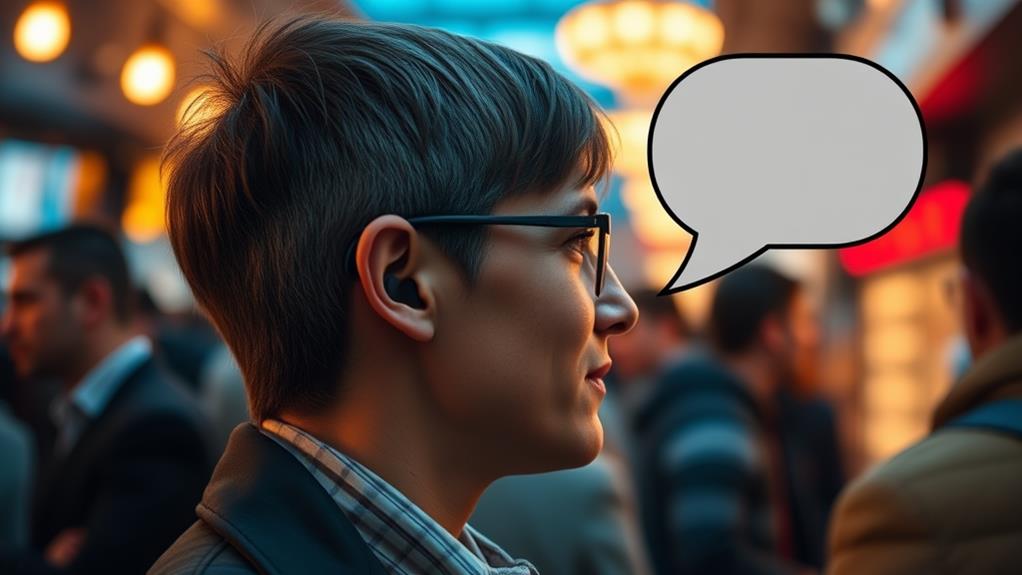You might find yourself wondering why your hearing aids struggle with background noise. The reason lies in the complexity of distinguishing between desired sounds, like speech, and unwanted noise in dynamic environments. Even with advanced algorithms and adaptive directional microphones, hearing aids can sometimes misidentify or muffle desirable audio, particularly in crowded or noisy settings. This challenge is a common issue that many users face, and there are several techniques and technologies designed to address it. Let’s explore some of the key factors and solutions that can help you navigate this challenge.
Key Takeaways
- Hearing aids struggle with background noise because they have difficulty differentiating speech from noise, especially in loud environments.
- Noise reduction algorithms can sometimes inaccurately identify desired sounds as noise, leading to muffled speech.
- Environmental factors and user preferences significantly affect the performance of noise reduction algorithms.
- The brain’s processing capacity is taxed when separating speech from background noise, leading to listener fatigue and frustration.
- Aggressive noise reduction can result in unnatural sound quality, requiring audiologists to balance speech benefits and realistic expectations.
Background Noise Reduction Techniques
Background noise reduction techniques are essential for improving the listening experience in hearing aids. You know the struggle – trying to hear your friend in a noisy cafe or understanding your family member in a crowded park. It’s like your brain is constantly playing a game of “spot the speech” amidst all the background chatter. But don’t worry, there are some cool techniques that can help.
First, there are directional microphones. These clever mics focus on sounds coming from the front, like your friend’s voice, and reduce the noise from the sides and back. It’s like having a personal sound engineer in your ear. This directional microphone technology utilizes advanced placement and algorithms to achieve ideal sound separation. But, it’s not just about the tech – environmental factors like the type of noise and the room’s acoustics also play a role. And, let’s not forget user preferences – some people like a bit of background noise, while others want it gone completely.
Noise reduction algorithms are another key technique. These smart systems analyze the sound and reduce the noise, making it easier to hear what you want. It’s like having a magic noise-cancelling button. But remember, it’s all about balance – you want to reduce the noise, not eliminate it completely, or it might sound unnatural.
Adaptive Directional Microphones
You’re probably wondering how hearing aids can help you tune out the background noise and focus on the conversation. Well, adaptive directional microphones are a game-changer – they automatically adjust to pick up sounds from the front, like your friend’s voice, and reduce the noise from the sides and back. This technology is like having a personal sound engineer in your ear, helping you hear what matters most. It’s ideal for social gatherings and crowded environments, enhancing overall communication by isolating desired audio.
Adaptive Microphone Technology
Adaptive microphone technology, also known as adaptive directional microphones, revolutionizes the way hearing aids handle background noise. Imagine being in a bustling cafe, where the hiss of steam and chatter of people can be overwhelming. Traditional hearing aids might amplify everything equally, making it hard to hear your conversation partner. But with adaptive directional microphones, your hearing aid can dynamically adjust its focus to prioritize the speech signal coming from your partner.
These microphones use sophisticated algorithms to detect the source of the sound and adapt the microphone sensitivity accordingly. This means that when you’re in a noisy environment, the hearing aid can reduce the amplification of background noise and enhance the sound coming from the person speaking to you. Contextual hearing capabilities further improve speech comprehension amidst loud background noise. This technology also helps with sound localization, allowing you to better pinpoint where sounds are coming from. So, whether you’re in a cafe or a car, adaptive directional microphones make it easier to follow conversations and enjoy clearer hearing in noisy situations.
Background Noise Reduction
The wearer’s ability to focus on speech signals in noisy environments is remarkably enhanced by the adaptive directional microphone technology, which dynamically adjusts to reduce background noise. This technology plays an essential role in improving user experiences in various hearing environments, such as busy restaurants or crowded public spaces.
Adaptive directional microphones work by continuously analyzing the sound environment and adjusting their focus to emphasize speech over background noise. This means that if you’re trying to have a conversation in a noisy cafe, the microphones will automatically tune in to the person speaking to you, making their voice clearer and more distinguishable from the ambient noise.
This technology is a game-changer for people with hearing loss, as it considerably reduces the effort needed to understand speech in noisy settings. With adaptive directional microphones, you can enjoy more comfortable and clear conversations, even in the most challenging environments. It’s like having a personal sound engineer in your ear, always tweaking the settings to give you the best possible listening experience.
Noise Reduction Algorithms

You’re probably wondering how noise reduction algorithms in hearing aids can help you tune out the background chatter and focus on what matters. Noise reduction techniques are designed to amplify speech while minimizing unwanted noise, but the catch is that these algorithms aren’t perfect and can sometimes muffle the sounds you actually want to hear. By understanding the limitations of these algorithms, you can better navigate the world of hearing aids and find the one that works best for you.
Noise Reduction Techniques
Noise Reduction Techniques
How can noise reduction techniques enhance the clarity of audio recordings? By using advanced algorithms to distinguish between speech and background noise, these techniques can greatly improve your listening experience in various hearing environments. The key is sound detection – identifying the sounds you want to hear and filtering out the ones you don’t.
Here are four ways noise reduction techniques can make a difference:
- Automatic Volume Adjustment: Modern hearing aids can automatically lower the volume in loud environments and increase it when speech is present, ensuring you hear what matters.
- Directional Microphones: These microphones focus on sounds coming from the front, reducing background noise from the sides and back, making conversations clearer.
- Noise Reduction Algorithms: By analyzing sound levels and frequencies, these algorithms can detect and reduce unwanted noise, enhancing speech clarity.
- Channel-Specific Noise Reduction: Advanced hearing aids can adjust noise reduction in different frequency bands, ensuring clear speech without compromising sound quality.
These techniques can transform your ability to communicate effectively in noisy environments, making everyday conversations more enjoyable and less frustrating.
Algorithm Limitations
Despite the advancements in noise reduction algorithms, several limitations can impact their effectiveness. You might be wondering why your hearing aids still struggle with background noise, even with fancy noise reduction features. Well, it’s because these algorithms aren’t perfect and can be affected by various factors.
One major limitation is algorithm accuracy. The algorithm might not always accurately distinguish between speech and noise, leading to over- or under-reduction of background noise. This can result in a less-than-ideal listening experience. Environmental adaptability is another limitation. The algorithm might not be able to adapt quickly enough to changing environmental conditions, such as moving from a quiet room to a noisy restaurant.
Don’t worry, though – these limitations don’t mean noise reduction algorithms are useless. They can still make a huge difference in your ability to hear in noisy environments. Just be aware of these potential limitations and work with your audiologist to find the best solution for your specific needs.
Feedback Reduction Algorithms
Feedback reduction algorithms play an essential role in enhancing the overall performance of hearing aids, particularly in noisy environments. These algorithms are designed to mitigate the annoying whistling sounds or echoes that can occur when sound from the hearing aid speaker is picked up by the microphone, creating a feedback loop. Effective feedback reduction is vital for improving sound quality and user comfort.
Here are four key aspects of feedback reduction algorithms that you should know:
- Adaptive Filtering: These algorithms use adaptive filters to continuously adjust and cancel out feedback signals in real-time.
- Signal Processing Techniques: Advanced signal processing techniques, such as phase cancellation and frequency shifting, are employed to minimize feedback.
- Algorithm Efficiency: The efficiency of these algorithms directly impacts the overall performance of the hearing aid, guaranteeing clear sound without annoying feedback.
- Real-World Performance: The best algorithms are tested in real-world conditions to verify they can handle various feedback challenges effectively.
Digital Signal Processing (DSP)

You’re probably aware that background noise can be a real challenge for hearing aid users. Digital Signal Processing (DSP) is a game-changer here, as it enhances audio quality by reducing noise interference and using advanced signal filtering. With DSP, you can expect clearer sound and less distraction from background chatter, making it easier to focus on what matters.
Enhancing Audio Quality
Modern hearing aids employ digital signal processing (DSP) to enhance audio quality, particularly in environments with background noise. DSP allows for advanced audio enhancement techniques that considerably improve sound quality. Here’s how it impacts your hearing experience:
- Sharper Sound: DSP helps filter out background noise, making voices clearer and easier to understand.
- Less Distortion: It corrects sound distortions, ensuring that what you hear is closer to the original sound.
- Noise Reduction: DSP can automatically reduce unwanted noise, like the hum of a fan or the chatter in a crowded room.
- Customization: It enables personalized settings to match your specific hearing needs, enhancing your overall listening experience.
With DSP, hearing aids can process sound more efficiently and with greater flexibility than analog systems. This technology is especially beneficial for people with sensorineural impairments who need to hear and understand speech in various environments. It’s not a magic solution, but it certainly makes a substantial difference in enhancing audio quality.
Reducing Noise Interference
Digital signal processing (DSP) plays an essential role in reducing noise interference in hearing aids. Let’s break it down – when you’re in a noisy environment, it can be really tough to focus on the sounds you actually want to hear. That’s where DSP comes in, helping your hearing aids to filter out the background noise and amplify the important sounds.
Here’s how it works: DSP converts sound signals into digital codes, which can be manipulated to reduce noise and enhance sound quality. This is especially helpful in challenging acoustic environments, like restaurants or shopping malls, where sound localization can be tricky. DSP can also help with sound localization, making it easier to pinpoint where sounds are coming from.
Now, you might be wondering if all hearing aids have DSP. The answer is no – some are just “digitally programmable,” which means they can be adjusted using a computer, but they don’t have true DSP capabilities. So, if you’re struggling with background noise, look for hearing aids with real DSP technology. Trust us, your ears (and your sanity) will thank you
Advanced Signal Filtering
In the domain of hearing aids, advanced signal filtering through Digital Signal Processing (DSP) stands as a cornerstone for enhancing sound quality and reducing noise interference. You see, traditional hearing aids were basic amplifiers, but modern devices go beyond that. They use sophisticated algorithms to analyze sound in real-time, distinguishing between desired sounds like speech and unwanted background noise.
Let’s break down why this matters:
- 1. Enhanced Speech Clarity: DSP helps you hear conversations clearly, even in noisy places like restaurants or offices.
- 2. Reduced Noise Interference: It filters out background noise, making your listening experience more comfortable and natural.
- 3. Improved Auditory Perception: With less noise, you can focus better on the sounds that matter, like someone talking to you.
- 4. Personalized Listening Experience: Many hearing aids with DSP can adapt to your specific environment and preferences, making your auditory experience more personalized and effective.
This technology isn’t just about turning up the volume; it’s about making sure you hear what you need to, without the noise getting in the way.
Automatic Adjustments
Automatic adjustments in hearing aids enable you to adapt to different environments seamlessly. This feature is a game-changer for managing background noise. Modern hearing aids can automatically adjust gain levels based on the surroundings, ensuring that you can focus on the sounds that matter most. This automatic gain control helps in sound prioritization, making it easier to distinguish between background noise and the conversation you want to hear.
For example, if you’re in a noisy restaurant, the hearing aids can automatically turn down the background noise and amplify the voices of the people you’re talking to. This technology is particularly useful in environments with varying sound levels, such as moving from a quiet room to a busy street. Automatic adjustments also help in minimizing the effort you need to put into adjusting your hearing aids manually, making the experience more comfortable and intuitive.
Customized Programming

Customized programming is an essential feature in hearing aids that helps you manage background noise effectively. It allows you to create personalized settings tailored to your specific needs and user preferences. This means you can enjoy a better listening experience in various environments, from noisy restaurants to quiet parks.
Here are some ways customized programming can make a big difference for you:
- Get the perfect settings for your favorite coffee shop: Imagine being able to hear your friend’s laughter over the sounds of espresso machines and chatter.
- Enjoy your music without the background noise: Switch to a program that amplifies the concert while minimizing the crowd noise.
- Hear your family clearly at dinner: Create a program that focuses on the voices around the table, not the TV in the background.
- Make meetings more productive: Use a program that cuts through the conference room noise, so you can focus on the discussion.
With customized programming, you’re in control of how you hear the world. It’s time to take your hearing experience to the next level and make background noise a thing of the past.
Connectivity Options
Your hearing aids become even more powerful tools when connected to other devices, enhancing your ability to manage background noise. Let’s explore how connectivity options can help you tackle those noisy environments.
First up, Bluetooth connectivity is a game-changer. It lets you stream audio directly from your phone or TV, cutting out surrounding noise. You can use streaming options to listen to music or podcasts without interference. Smartphone integration takes it a step further, allowing you to control your hearing aids with an app. This means you can adjust settings on the fly to better hear in noisy places.
Wireless compatibility also means you can pair your hearing aids with multiple devices at once. Imagine being able to switch between your phone, TV, and computer seamlessly. App features like remote control let you tweak settings without touching your hearing aids. Plus, audio sharing allows you to share sound with others, like in a meeting or at dinner. It’s all about making your hearing aids work smarter, not harder, to help you navigate background noise with confidence.
Artificial Intelligence (AI) Integration

Artificial Intelligence (AI) Integration
AI advancements are changing the game for hearing aids, especially when it comes to background noise. With machine learning, these devices can now adapt to your surroundings, prioritizing the sounds you want to hear and reducing the noise you don’t. Here’s how it works:
- Real-time sound analysis: AI algorithms process sound waves as they happen, distinguishing between speech and background noise.
- Personalized sound settings: Machine learning helps your hearing aids learn your preferences and adjust settings automatically for different environments.
- Noise reduction: AI-powered hearing aids can greatly reduce background noise, making conversations clearer and less taxing.
- Continuous learning: These devices learn from your interactions and adapt over time, ensuring your hearing experience is always improving.
Wireless Hearing Aid Accessories
Wireless hearing aid accessories offer a range of benefits to enhance your listening experience. With these nifty tools, you can tackle background noise like a pro. Let’s explore the world of wireless compatibility and examine the accessory benefits that can revolutionize your hearing.
First off, TV streamers are a game-changer. They let you stream audio straight to your hearing aids, so you can watch your favorite shows without cranking up the volume. And with remote microphones, you can hear conversations clearly even in noisy environments. Table microphones are another cool gadget that can help you focus on the speaker in meetings.
Remote controls are also super handy, allowing you to adjust volume and switch programs discreetly. And, let’s not forget about phone clips that turn your hearing aids into wireless headphones. All these accessories are designed to help you navigate background noise with ease. So, what are you waiting for? Get connected and start hearing the world in a whole new way.
Conclusion
Dealing with background noise can be a real pain, but your hearing aids shouldn’t make it worse. Advanced hearing aids use tech like adaptive directional microphones and noise reduction algorithms to help you hear better. But, they’re not perfect and can sometimes muffle the good stuff. Work closely with your audiologist to fine-tune your hearing aids for different situations. It’s like having your own personal sound engineer – minus the fancy degree.








